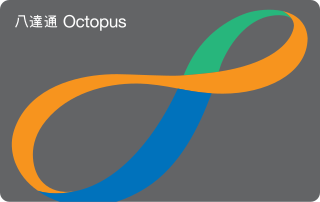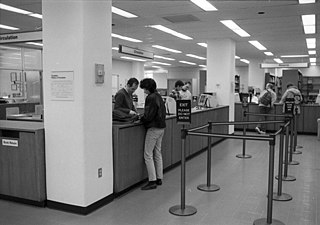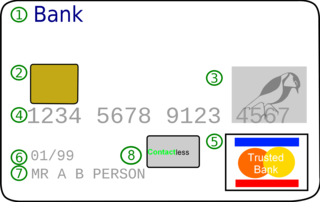This article needs additional citations for verification .(November 2017) |
The Browne Issue System is an old system for loaning library books, developed by Nina Browne in 1895. [1]
This article needs additional citations for verification .(November 2017) |
The Browne Issue System is an old system for loaning library books, developed by Nina Browne in 1895. [1]
When a book was borrowed the librarian took one of the reader's "borrowing cards" and removed the book's own card. These two cards were filed together with the date stamped in the book. These cards are "tickets" that are arranged in trays by date of issue and within date by the key on the card.
When the book was returned, the user's card was removed from the file of the day indicated by the stamp and given back, and the book card was replaced in the book. Whilst the filed cards revealed which user had a particular book, or which books a particular reader had borrowed, this was only true whilst the loan continued. Afterwards no record of the transaction remained. [2] [3]
A reader can quickly see how many more books they can borrow (before handing any in) by the number of cards they have remaining. The librarian can look at the tray and instantly visualise the number of transactions that day.
The system is based upon cards and cardboard/paper slips: it is a low-technology approach yet proven over 100 years to be robust and scalable to work even in large libraries. Training can be completed in a small number of hours, and the cost of implementation is mostly centred on labour. Therefore, it is still a suitable solution for small loan libraries where financial resources are limited, or in locations where a computer based solution is not suitable (e.g. lack of equipment, guaranteed electrical supplies).
There is a lot of manual processing of the cards in the trays. Each day, the issues have to be ordered and added to the trays. When a book is returned, the identification 'key' and date of return guide you to the card location in the trays.
When a book is reserved, somebody needs to check the catalog, and, if the book is not on the shelf, look for the relevant card in the trays. This involves manually looking for the card with the matching 'key' in the trays, sequentially looking in each date until found. A reserved item is flagged with a piece of colored card, so that when it is returned it can be set aside and checked against the file of reservations.
Renewals involve finding the ticket and moving it to its new location in the trays. Typically, a small number of 'queries' will mount up, cases where something goes awry because a card or ticket is misdirected in some way. These may consume quite a bit of time to sort out.
A tray of cards dropped on the floor could prove catastrophic and require a substantial amount of time to re-sort.
The simple, reliable and speedy method was replaced in America by the Newark and Detroit methods and others based on them. The advent of technology within libraries, such as barcode scanners, eliminated card-based systems.
The reference desk or information desk of a library is a public service counter where professional librarians provide library users with direction to library materials, advice on library collections and services, and expertise on multiple kinds of information from multiple sources.

A smart card (SC), chip card, or integrated circuit card is a physical electronic authentication device, used to control access to a resource. It is typically a plastic credit card-sized card with an embedded integrated circuit (IC) chip. Many smart cards include a pattern of metal contacts to electrically connect to the internal chip. Others are contactless, and some are both. Smart cards can provide personal identification, authentication, data storage, and application processing. Applications include identification, financial, public transit, computer security, schools, and healthcare. Smart cards may provide strong security authentication for single sign-on (SSO) within organizations. Numerous nations have deployed smart cards throughout their populations.
Radio-frequency identification (RFID) uses electromagnetic fields to automatically identify and track tags attached to objects. An RFID system consists of a tiny radio transponder, a radio receiver and transmitter. When triggered by an electromagnetic interrogation pulse from a nearby RFID reader device, the tag transmits digital data, usually an identifying inventory number, back to the reader. This number can be used to track inventory goods.

A library catalog is a register of all bibliographic items found in a library or group of libraries, such as a network of libraries at several locations. A catalog for a group of libraries is also called a union catalog. A bibliographic item can be any information entity that is considered library material, or a group of library materials, or linked from the catalog as far as it is relevant to the catalog and to the users (patrons) of the library.

The Octopus card is a reusable contactless stored value smart card for making electronic payments in online or offline systems in Hong Kong. Launched in September 1997 to collect fares for the territory's mass transit system, it has grown into a widely used system for transport and other retail transactions in Hong Kong. It is also used for purposes such as recording school attendance and permitting building access. The cards are used by 98 percent of the population of Hong Kong aged 15 to 64 and the system handles more than 15 million transactions, worth over HK$220 million, every day.

A time clock, sometimes known as a clock card machine or punch clock or time recorder, is a device that records start and end times for hourly employees at a place of business.

MIFARE is a series of integrated circuit (IC) chips used in contactless smart cards and proximity cards.
A credit history is a record of a borrower's responsible repayment of debts. A credit report is a record of the borrower's credit history from a number of sources, including banks, credit card companies, collection agencies, and governments. A borrower's credit score is the result of a mathematical algorithm applied to a credit report and other sources of information to predict future delinquency.

Payment cards are part of a payment system issued by financial institutions, such as a bank, to a customer that enables its owner to access the funds in the customer's designated bank accounts, or through a credit account and make payments by electronic transfer with a payment terminal and access automated teller machines (ATMs). Such cards are known by a variety of names including bank cards, ATM cards, client cards, key cards or cash cards.

A contactless smart card is a contactless credential whose dimensions are credit card size. Its embedded integrated circuits can store data and communicate with a terminal via NFC. Commonplace uses include transit tickets, bank cards and passports.
A computer operator is a role in IT which oversees the running of computer systems, ensuring that the machines, and computers are running properly. The job of a computer operator as defined by the United States Bureau of Labor Statistics is to "monitor and control ... and respond to ... enter commands ... set controls on computer and peripheral devices. This Excludes Data Entry."

Library circulation or library lending comprises the activities around the lending of library books and other material to users of a lending library. A circulation or lending department is one of the key departments of a library.

A library card can refer to several cards traditionally used for the management of books and patrons in a library. In its most common use, a library card serves similar functions as a corporate membership card. A person who holds a library card has borrowing or other privileges associated with the issuing library. The library card also serves as a method of identification. When a person chooses an item to borrow and presents their library card to the library, they take responsibility for the borrowed item and promise to abide by certain rules, usually including a promise to return the item by the due date or face a library fine. If the cardholder violates these responsibilities, their borrowing privileges may be suspended.

Manual fare collection is the practice of collecting fares manually. "Fare collection" generally refers to the collection of fares in the transport industry in return for a ticket or passes to travel. Commonly used on buses and train transport systems, manual fare collection is increasingly becoming obsolete with the introduction of smart cards such as the Transport for London 'Oyster card'. However, in the face of this trend, some companies have opted to retain more traditional methods of manual fare collection to both save money and ensure reliability. In the United Kingdom, examples of this can be seen on the Transport for London Heritage lines and the FirstGroup FTR routes in York, Leeds, Luton, and Swansea where bus conductors have returned to work. The other reason(with lowering prices of electronics, and in most cases need to buy it once) may be for Heritage routes - tradition "look", for other routes(because of quite high monthly labor cost in UK) agreements and strong unions with the tries from politics to lower the unemployment rate by making overworking in public service.

The Estonian identity card is a mandatory identity document for citizens of Estonia. In addition to regular identification of a person, an ID-card can also be used for establishing one's identity in electronic environment and for giving one's digital signature. Within Europe as well as French overseas territories and Georgia, the Estonian ID Card can be used by the citizens of Estonia as a travel document.

The OV-chipkaart is a contactless smart card system used for all public transport in the Netherlands. First introduced in the Rotterdam Metro in April 2005, it has subsequently been rolled out to other areas and travel modes. It fully replaced the national strippenkaart system for buses, trams, and metro trains in 2011, and the paper ticket system for rail travel in July 2014.
A digital ticket is a virtual instance of a ticket which represents the digitization of rights to claim goods or services. The first ever digital Dynamic Barcode, invented by Alan Amron in 2011, was the first digital eChanging dynamic barcode. In 2015 a US patent was issued for this first ever dynamic barcode, to prevent digital fraud. Patented dynamic eChanging digital barcode QR code to prevent digital ticket fraud. It is the digital age version of today's stagnant still static barcodes, continually updating the digital barcode, QR code, Alphanumerical or any discernable image from a static one to a rotating one that cannot be duplicated to prevent digital ticket fraud. USPTO Amron Patent number: 9047715 Filed: Dec 6, 2011 Date of Patent issued: Jun 2, 2015 Dynamic Barcode!, USPTO Don't Strike Out at the Gate - Los Angeles Angels MLB has launched Protect the Barcode technology at Angel Stadium, updating the digital barcode from a static one to a rotating one that cannot be duplicated. News Press April 2023.

A credit card is a payment card issued to users (cardholders) to enable the cardholder to pay a merchant for goods and services based on the cardholder's accrued debt. The card issuer creates a revolving account and grants a line of credit to the cardholder, from which the cardholder can borrow money for payment to a merchant or as a cash advance. There are two credit card groups: consumer credit cards and business credit cards. Most cards are plastic, but some are metal cards, and a few gemstone-encrusted metal cards.

The term digital card can refer to a physical item, such as a memory card on a camera, or, increasingly since 2017, to the digital content hosted as a virtual card or cloud card, as a digital virtual representation of a physical card. They share a common purpose: Identity Management, Credit card, or Debit card. A non-physical digital card, unlike a Magnetic stripe card can emulate (imitate) any kind of card. Other common uses include loyalty card and health insurance card; physical driver's license and Social Security card are still mandated by some government agencies.
Uniterm is a subject indexing system introduced by Mortimer Taube in 1951. The name is a contraction of "unit" and "term", referring to its use of single words as the basis of the index, the "uniterms". Taube referred to the overall concept as "Coordinate Indexing", but today the entire concept is generally referred to as Uniterm as well.